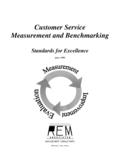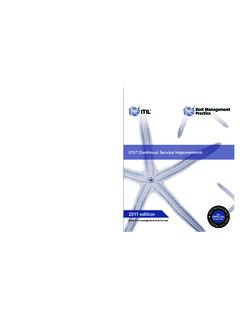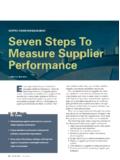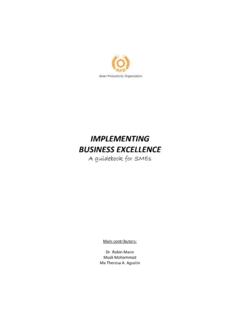Transcription of Benchmark Against Best Practice Service Delivery Metrics
1 Benchmark Against best Practice Service Delivery Metrics Featuring: Julie Giera, Forrester Pierre Champigneulle , BearingPoint Host: Jason Schroedl, newScale Internal Service Delivery The average company spends between 3 percent and 15 percent of its total revenue delivering services to internal departments Service Organization Example services IT Desktop setup Application access & hosting Telecom Cell phones Home office connectivity Facilities Office/Furniture moves HVAC maintenance Security Building access control Pre-employment screening Today's Service Delivery Landscape Requires New Approach % of National Survey Respondents Market Factors Unhappy with Internal services 50% 43%.
2 Increase in Outsourcing Economic Pressures 40%. 32%. IT Credibility at Risk 30%. Cost Reduction Imperatives 22%. User Frustration 20%. Business/IT Alignment 10%. Maturation of Technologies Catalysts (M&A) 0%. Employee Heating IT & Network Moves Adjustments services Source: TNS National Omnibus Survey (9/03). Benchmark Against best Practice Service Delivery Metrics Julie Giera Vice President Forrester Research Theme benchmarking is increasingly being used by best Practice organizations to gauge their effectiveness, manage their Service provider relationships, and align spending to business outcome. Agenda What is benchmarking ?
3 Trends in Service Delivery Management benchmarking Methods, Pros/Cons benchmarking for Competitive Advantage Metrics and Measurements Evolution of benchmarking It's all about the Business benchmarking Definition Benchmark : A standard by which something can be measured or judged benchmarking : To measure (a rival's product or Service ) according to specified standards in order to compare it with and improve one's own product (or Service ). Trends in Service Delivery Management Increases in benchmarking external and internal services , due to: Continued emphasis on cost savings Increases in outsourcing, length of agreements Pay for Performance as a financial schema Increased emphasis on business impact of services Desire to align spending with outcome Polling Question 1.
4 Does your internal services organization have a benchmarking program? No, not yet We are evaluating benchmarking programs We engage in periodic, ad-hoc benchmarking projects We have a formal and comprehensive benchmarking program for Service Delivery benchmarking Methods benchmarking initiatives are often driven by pressure from CFOs and CEOs Example benchmarking methods: RFI, RFP to external providers benchmarking projects Compass, IDC, etc. benchmarking organizations Analyst firms Management consultancies efficiency studies Ongoing internal component of Service Delivery Few Internal Service Teams Measure Value My Organization Has a Defined Program to Measure the Value of Internal Service Delivery : 100%.
5 90%. 80%. 70%. 60%. 50%. 40%. 30%. 20%. 10%. 0%. 2001 2002 2003 2001 2002 2003. True False What are you measuring? Few companies measure value of IT. Most firms concentrate exclusively on technical Metrics (availability, response time). Few companies know full cost of services they deliver Even fewer (less than 2%) can consistently tie Service Delivery to business value benchmarking studies give averages'. benchmarking is historical Average IT spend in 2004 is of revenue. If you are spending 4% - are you better or worse than your peers? Business Focus Changes the Relationship The IT Department enabled: A 10% gain in sales Time to market The IT Budget is improvements of 30%.
6 20% more orders/hour going up by 7% next 2% reduction in SG&A. year expense Metrics and Measurements Several kinds of value Direct vs. Indirect Anticipated vs. Unanticipated Several kinds of Metrics : Commitment Metrics (contract or SLA). Bonus Metrics (qualify for incentives). Improvement Metrics (early warnings, diagnostics). The Four IT Perspectives Sample User Orientation Perspective Polling Question #2. Does your organization have a program to measure customer (employee). satisfaction with Service Delivery ? No formal customer feedback mechanisms Yes, we have an annual survey/program Yes, we have surveys on a quarterly basis Yes, we have an on-going program to regularly solicit customer feedback and incorporate feedback into improving processes Sample Operational Excellence Perspective benchmarking for Competitive Advantage benchmarking is NOT exclusively about cost Understand the context of your unique Service Delivery situation benchmarking can assist with.
7 Prioritizing investments and services Aligning Service Delivery with business value Identifying problems Making outsourcing decisions benchmarking for Competitive Advantage benchmarking is about: Service quality, Service Level Customer satisfaction Cost vs. value (profit/employee, customer retention, market share, DSO reductions). Process (responsiveness, security). Time (request to fulfillment, problem resolution time). benchmarking for Competitive Advantage best practices Estimate a baseline (based on data from commercial services providers, analyst firms, benchmarking organizations, etc.). Measure cost, effectiveness, quality, impact of services Estimate diagnostic Metrics , early warnings Don't boil the ocean, 80/20 rule, focus on 3-5.
8 Metrics /category Use as ongoing business tool to track your Metrics , not a once-a-year price snapshot benchmarking for Competitive Advantage Use benchmarking for external partners Use benchmarking clauses in contracts . but get baselines! Pricing trends in the market Trends in SLA standards Productivity (tech's per server, calls/help desk expert). Emerging technology impact Provide incentives for partners to improve Recommendations Change Focus of Your Service Org (Cost vs. Value). Use benchmarking and Metrics as part of: Ongoing Service Delivery processes Project selection/justification/optimization Vendor selection/mgmt/sourcing decisions Establish accountability for all Metrics Limit total commitment/bonus Metrics Incorporate Metrics early in process, work with business to establish Automate collection/reporting of Metrics Start small, build skills and credibility Avoid retroactively determining value, start with a baseline & go forward Summary benchmarking can be useful.
9 But is often abused Metrics are more than cost Great Service Delivery organizations tie services to outcome Automated tools to track your Metrics save time/money, & serve as diagnostics benchmarking results must be viewed in context of your unique organization Benchmark Against best Practice Service Delivery Metrics Pierre Champigneulle Managing Director BearingPoint Introduction benchmarking Process of improving performance by continuously identifying, understanding, & adapting outstanding practices & processes found inside & outside organization. This presentation looks at services mgmt benchmarking from a best practices standpoint services Management best practices Benefits Business Drivers best practices Benefits Changes in the Business Provide reference to set direction and roadmap Environment Guidelines to satisfy regulation & security req's Facilitate M&A & alignment across regions Increased Business Set expectations.
10 Agree to performance/cost ratio Expectations New Business Initiatives Help plan & implement necessary capabilities Profitability Pressures Increase automation & reduce inefficiencies Customer Satisfaction Measure Customer QoS via end-to-end SLM. Align Service portfolio & Service levels to business needs of each potential customer Sourcing Develop best -in-class Service Level Management (SLM) capabilities to enforce SLAs Develop control & audit capabilities for key mgmt functions What services Management Functions to Benchmark Service Management Functions Delivery Support Financial Business Layer Mgmt Service Continuity Focuses on capabilities Vendor/Outsource Asset Mgmt Mgmt Strategic necessary to run Network & IT.




